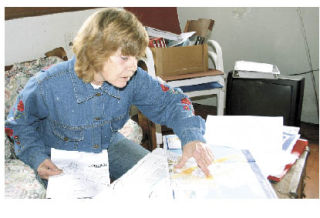Island County’s new “accident potential zones” faced two challenges filed with the Western Washington Growth Management Hearings Board.
North Whidbey resident Becky Spraitzer already has a schedule of hearings before the board. She filed a petition asking that the ordinance be remanded because, she argues, it was adopted without “effective notice of early and continuous public participation.”
“The vast majority of people were not notified,” she said. “A lot of people still don’t know they will be affected.”
The city of Oak Harbor also filed a petition against the county alleging that the ordinance appeared to overstep the county’s jurisdiction by extending the zoning within the city or to land slated to be annexed into the city.
The property in question is in the industrial and commercial area of Goldie and Ault Field roads. City officials don’t want development restriction on the economically valuable area.
The petition was dismissed after the City Council and Island County Commissioners approved a memorandum of understanding.
“The county acknowledges that zoning within the city of Oak Harbor is the province of the city,” the document states.
But at the council meetings last week, several city officials and citizens made it clear they didn’t support the county’s APZ ordinance in general. The ordinance has been largely credited to Island County Commissioner Mac McDowell.
“In fact, filing a lawsuit indicates we didn’t support the whole idea,” said former City Attorney Phil Bleyhl, who handled the case for the city.
The ordinance in question, adopted March 10, sets development restrictions around Whidbey Island Naval Air Station. The Navy created a map of recommended APZs, which are areas at the end of runways where airplane crashes are most likely to occur.
In updating the county’s Comprehensive Plan, county officials decided that the Navy’s recommended APZs were not adequate. The county greatly extended the APZ to include a racetrack formation around the base. Within the zone, the ordinance sets restrictions on subdivisions and on uses, specifically those that would result in a number of people congregating at one spot. Restrictions in APZ1, the area with the highest risk, include daycare nurseries, schools, veterinary clinics, bed and breakfast facilities, and community gathering places like churches.
County Planning Director Jeff Tate said the purpose of the ordinance is to protect the community. He explained that the county decided to do it now while the area in question is still largely rural.
“Right now, there’s very much a recognition that the population in the county is increasing. That creates pressure to build,” he said.
On the other hand, Councilman Jim Campbell, who has a military background, said protecting the community is important, but that the county’s ordinance goes too far. He said the racetrack formation is simply not an accident potential zone. The Navy sets APZs in the areas immediately after take-off.
“They are zones where a plane is most likely to fall out of the sky,” Campbell said. The racetracks cover areas where airplanes are safely circling thousands of feet in the air, he said.
Oak Harbor has its own accident potential zones where development is restricted. But the city’s overlay zones largely follow the Navy’s recommendations, with only a small strip of land added to the APZ map.
The memorandum of understanding sets up a unique situation in which land just outside city limits has significantly different zoning rules than property inside the city. Goldie Road and Ault Field businesses that are in the city’s urban growth area — the land earmarked for eventually annexation into the city — will have to follow the county’s regulations until they annex into the city.
“This might be an incentive for those properties to come into the city as soon as possible,” Bleyhl said, but he also acknowledged that the county’s ordinance could stifle business in the area.
On the question of public notification, Tate said he’s confident that the county followed all legal requirements by running legal notices in newspapers and holding a series of public hearings. He said only six property owners were notified via mail because they would be most affected by the ordinance. They are the only people with property large enough to subdivide under the old rules. And now they can’t.
Spraitzer, however, argues that the public notification obviously wasn’t effective since most people didn’t know they would be impacted until after the ordinance was passed. She said that a large group of concerned residents will help her with the appeal, including the hiring of an attorney.
Beyond the legal remedy, Spraitzer said she’s also trying to apply political pressure in this election year. She’s collecting signatures for two different petitions — one for affected folks and one for county residents — that ask the commissioners to remand the ordinance.
“It’s been a grassroots effort,” she said. “I get about four calls a day.”



